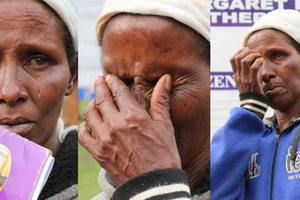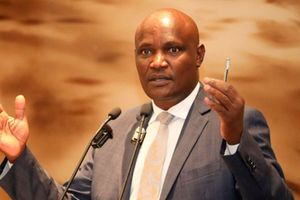The SHIF transition: Stop fooling Kenyans

Health Cabinet Secretary Deborah Mulongo Barasa during the launch of Social Health Authority held at Central Primary School in Eldoret City on October 1, 2024.
What you need to know:
- These tariffs allocated by SHIF will never be able to provide any level of quality care for anyone.
- Forcing all mothers to attend antenatal care in level two and three facilities is not, and will never be the solution for quality healthcare.
This week, the grand transition from the National Health Insurance Fund to the Social Health insurance fund happened. And as usual, we did it the great Kenyan style, head on, taking no hostages and hoping we will figure it out as we go!
And why is that? Because we have done it before and survived, as long as you don’t ask about the quality. We did transition into free primary education in 2003 as a fulfilment of the election pledge made by former President Mwai Kibaki. Overnight, we had to live with the madness of overcrowded classrooms, severe shortages of teachers and makeshift classrooms that did not meet safety standards for a learning institution.
Fast forward to the next decade, and the popularity contest was back. The next regime plunged us into the world of free maternity care. When the clock struck midnight on June 30, 2014, it was bedlam in our maternity units as mothers trickled into the wards with insufficient personnel to handle the crazy numbers.
Here we are again, we clearly don’t seem to want to learn to do this in any other way except through mayhem. Last Tuesday, we went on to implement the new Social Health Insurance Fund (SHIF). Well, let’s just say that we have no clue who SHIF is supposed to serve. Hospitals that are intended to provide care have been restricted to only provide this care after the patient has had a run at the local primary care facility and the gotten referred.
So basically, in an effort to implement article 43 of the Constitution on right to health, we are clearly mangling this up in a big way, with the hope that we shall figure it out as we go. Unfortunately, this isn’t about a few missed classes; or a missing teacher, or a cracked classroom floor. It is about an immediate need for access to care that saves two lives at the same time.
The Social Health Insurance Act 2023 brought the Social Health Authority to life, mandated to oversight the social health financing for Kenya. The Authority is intended to oversight over the Primary Healthcare (PHC) Fund, the SHIF and the Emergency, Chronic and Critical (ECC) care fund. While the Social Health Insurance draws its funding from contributions made by all Kenyans directly, the Primary Healthcare Fund and the Emergency, Chronic and Critical care funds draw directly from the Exchequer, as appropriated by the National Assembly.
While Kenyans have been kept busy with the contentious contributions for SHIF, some key important elements have been left to slide, with no proper regulation, stakeholder engagement and informed decision-making. All persons are supposed to be confined to a primary healthcare network, where they are supposed to receive free care as this is catered for under the PHC fund. Unfortunately, there is no such thing as free. It is only free up to Sh900 per head p.a. Beyond there, despite contributing thousands to SHIF annually, you will fork out the extra out of your pocket.
For instance, according to the Act, chronic illness is defined as a condition that lasts one year or more and requires ongoing medical attention or limits activities of daily living or both. Now, nothing is said of chronic illnesses that do not last a year. Additionally, there is no clear tariff for chronic illness care in level 4, 5, and 6 in the outpatient. The tariffs prescribed only speak to the tests to be done, allowable once a year and capped at amounts that are not sustainable.
I am no cardiologist, but to see a hypertensive patient allocated Sh2,850 p.a. for their care is insulting. The minimum standard of care for these patients involves antihypertensive medication all year round, annual tests to check on their heart, liver, and kidney function, alongside their cholesterol levels at the bare minimum. How do they pay for consultation, drugs and other tests not listed in the tariff?
Further, in the inpatient, ECC package is not even comprehensible. ICU care limits range from Sh3,360 to Sh4,480 per day for a maximum total of 180 days; a unit where one dose of a drug used will cost more than that. The chronic illness cover can only be invoked once your SHIF limits run out. However, the hidden clause in there states that this shall be covered comprehensively, “subject to budgetary allocation”.
So I looked at the main Act to find out how it compels the National Assembly to make available adequate funds to cover for these two key areas that are exchequer-funded; the PHC allocation and the ECC allocation. The Act is completely silent. The reasonable thing would be to state a fixed percentage of our annual budget as an annual allocation. This has not been done.
The PHC Act places the burden of funding primary healthcare on counties, “supported by the national government”. The largest portion of total receivables for the funding of healthcare is from SHIF contributions. However, drawing from this fund has been cleverly covered by forcing everyone to start at PHC level for care first so as to spend what the exchequer allocates, while leaving the billions of shillings we shall contribute directly, relatively untouched. Most people need outpatient care, not in-patient care. What are we missing?
The government needs to STOP telling Kenyans that they will no longer pay any money out of pocket to access care. The reality on the ground is absolutely different. Where is the diligence on the part of government to actually establish the true cost of care for the services? We have lessons in existence, to draw from. The existing Linda Mama programme has not worked in most facilities for a long time.
Level 4 and 5 health facilities that have been taking the bulk of the maternity patients served in the public health sector. In order to maintain the quality of care, the patients have had to co-pay for years now. The antenatal clinic attendance is paid for, the antenatal lab tests and ultrasounds are all paid for and during delivery, the patients have had to top up cash payments to enable them to get quality maternity care.
Who are we fooling? These tariffs allocated by SHIF will never be able to provide any level of quality care for anyone. Forcing all mothers to attend antenatal care in level two and three facilities is not, and will never be the solution for quality health care. It is actually a contravention of the freedom of association that the constitution entitles to every Kenyan. We are essentially forcing people to pay for services directly under the guise of opting out of the PCN (primary care networks) so as to force payment for the Facility Improvement Financing Act without drawing from SHIF.
We are a nation that pays Sh134,400 for surgery of an ectopic pregnancy, and then we pay Sh30,000 for a caesarian section. In my boggled mind, I am trying to figure out how surgery involving two lives costs less than 25 per cent of the cost of surgery saving one life. It will never be universal health coverage until it is first and foremost defined by quality!
Dr Bosire is a gynaecologist/ obstetrician




